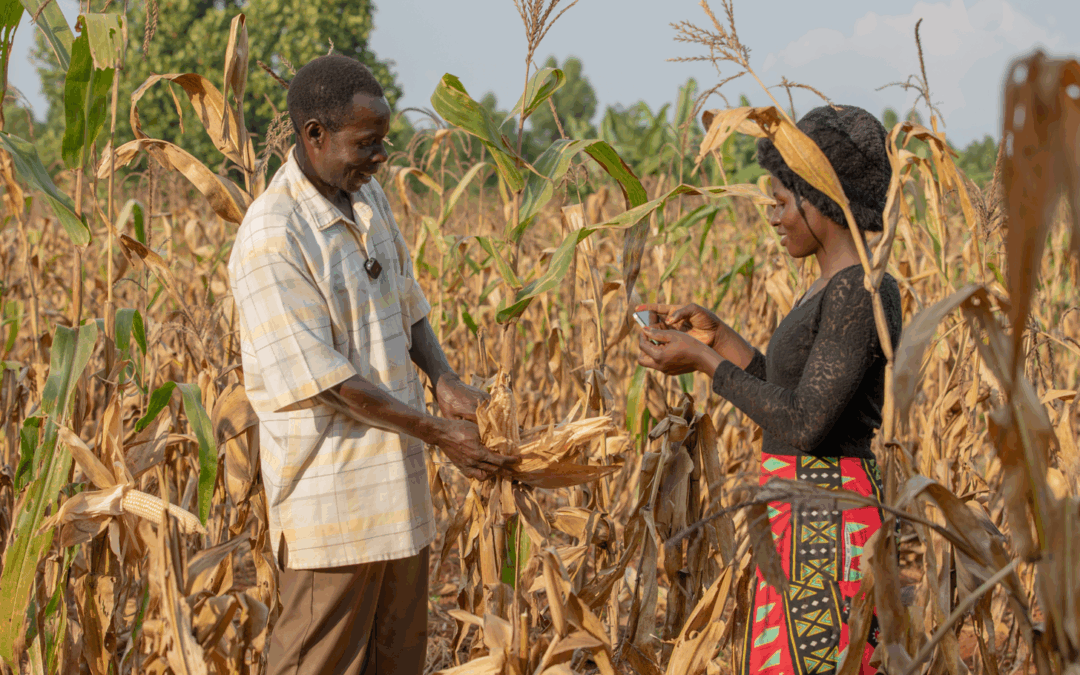By Elizabeth Asiimwe and Kristin Davis.
Generative Artificial Intelligence (Gen AI) is a type of artificial intelligence that can create new content such as text, images, audio, video, or even computer code, based on the data it has been trained on. Generative AI is trained on huge amounts of data (like books, images, and conversations), and it learns patterns. When prompted, it uses the learned patterns to generate something new that fits the request.
Agricultural Extension in Uganda
In Uganda, agricultural extension and advisory services (AEAS) remains the “heart and soul” of the Ministry of Agriculture, Animal Industry, and Fisheries’ (MAAIF) knowledge base. It is the farmer’s support system for learning, innovation, and problem-solving, as well as one of the most essential elements for agricultural sector transformation.
There is evidence that agricultural extension is linked to improved agricultural production, and a recent study from Uganda adds a positive link with food security.
Uganda’s extension system is structured through a pluralistic approach, whereby multiple actors, such as government agencies, NGOs, private agribusinesses, farmer cooperatives, and development partners, provide agricultural extension services to farmers. Despite this, AEAS faces persistent bottlenecks such as: i) a wide ratio of extension workers to farmers (1:~1800), which is far beyond the Food and Agriculture Organization’s recommended ratio of 1:500; and ii) uncoordinated and at times confusing messaging.
According to MAAIF, Uganda has approximately 5,000 frontline extension workers serving more than 6.9 million farming households. As of 2023, only 24% of Ugandan farmers regularly accessed extension services, leaving the majority without crucial knowledge on modern farming techniques.
This gap means that many farmers cannot access advisory services in a timely manner, particularly during critical periods such as planting and harvesting, which threatens not only agricultural productivity but also food security.
Digitalisation of agriculture holds the promise
Over the past decade, Uganda, like many countries, has seen an increased use of digital tools in agricultural extension, particularly with the introduction of smartphones. While the government is developing its national agricultural digitalisation strategy, several initiatives, agritech companies, such as m-omulimisa and ezyagric, have enabled farmers to access weather forecasts, market information, and agronomic advice via mobile phones. Similarly, initiatives such as UFAAS AIRTEA digital connectors have demonstrated that digital tools help to bridge the wide gap between extension workers and farming communities digitally. These digital innovations have improved access to information, particularly for youth and literate farmers. However, challenges such as limited connectivity, affordability of smartphones, and low digital literacy mean that access remains uneven. But can these digital innovations scale without involving people? In a recent discussion by D4Ag, stakeholders said that it is tough to scale any digital technology without involving humans.
Artificial Intelligence, the new frontier in agricultural extension
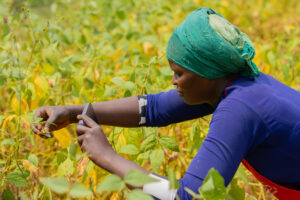
A woman farmer takes a photo of a diseased soybean leaf in Bugiri, Uganda. Photo: UFAAS
The new frontier in the digitalisation of agriculture is Artificial Intelligence (AI). AI is already making a significant impact across Sub-Saharan Africa, with innovative applications and an expanding reach through customized extension messages. From helping farmers and extension workers identify crop diseases early by uploading photos of affected plants, and receiving instant diagnoses and treatment recommendations, AI holds promise.
For agricultural extension specifically, studies indicate that AI large language models (LLMs), including ChatGPT have the potential to advance the impact of agricultural extension through making extension services more accessible and relevant to a wider range of farmers. For the m-omulimisa AI in extension service, farmers simply text “Manya” (which means “know” in the Luganda language) followed by their question, and send it to 8228. The AI-powered system then provides a clear and practical response instantly, enabling the farmer to proceed with confidence.
As new digital tools and AI enter the agricultural extension space, important questions emerge: What strategies help us to have truly effective conversations with farmers? How do empathy, adaptation, and local knowledge shape advisory success? How can we design digital systems that are realistic, respectful, and inclusive? And, just as importantly, what are the limits of what AI can and should do?
These questions were central to a recent workshop held in Kampala, convened by the International Food Policy Research Institute (IFPRI) and the Uganda Forum for Agricultural Advisory Services (UFAAS). Held on 23rd September at Hotel Africana, the workshop was attended by stakeholders (mainly extension workers) from across Uganda’s pluralistic agricultural extension system – government agencies, NGOs, research organisations, the private sector, and farmer institutions from different regions of the country. It explored how AI could be designed and trained to meet the needs of both extension workers and farmers, as well as the role that Generative AI can play in agricultural extension.
At the onset of the workshop, participants were asked to describe what they considered a good extension worker. The majority indicated that the extension worker should be tech-savvy and up-to-date with digital tools. Others mentioned: agile, a teacher, patient, creative, a servant worker, an advisor on many things, a connector, a good listener, and an all-round person. Following a presentation on Generative AI in agricultural extension, participants discussed and shared their thoughts in both group and plenary sessions about the role of AI in agricultural extension and advisory services.
The workshop revealed both optimism and caution.
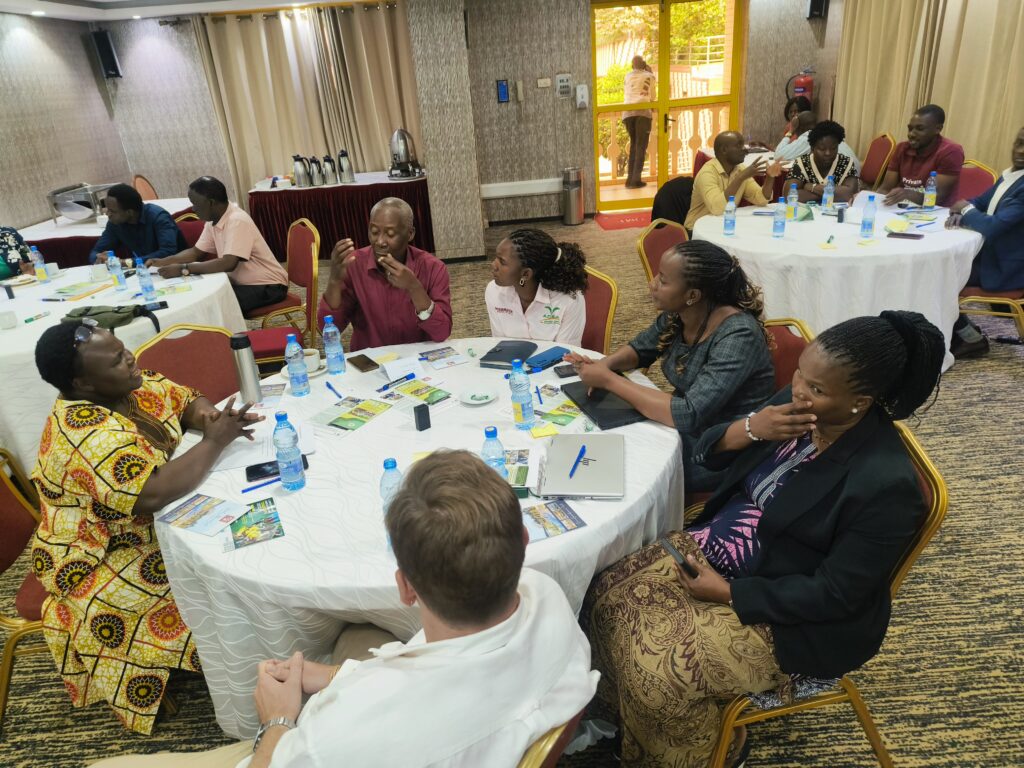
Group discussions during the IFPRI – UFAAS Gen AI workshop in Kampala. September, 2025
Insights from the extension stakeholders
- We need AI for Quick Diagnosis
Participants agreed that AI has the potential to localize and provide on-spot diagnosis when trained on farmer contexts. Yet, they noted that “probing,” the art of asking the right questions and interpreting hidden cues, remains a uniquely human skill. As one participant observed, some farmers deliberately hold back information to test whether the extension worker is truly knowledgeable.
- AI as an Enabler, Not a Competitor
There was fear that AI could displace extension workers. AI is not here to displace jobs, but to supplement traditional extension systems. One participant shared how they had used an AI tool to identify a stubborn weed in their garden. They believed how smart AI is, and had a deeper reflection: if “AI can help with something as practical as spotting a weed, what more could it do in agricultural extension?” A combined approach is best, where AI provides quick advisory responses on topics such as irrigation scheduling, soil fertility assessments, or pest detection. At the same time, extension workers focus on building relationships and facilitating social learning.
- Context Matters: Localized Diagnosis
Participants agreed that effective extension begins with probing the farmer’s context. Farmers often reveal challenges in indirect ways – sometimes even withholding information to test whether an extension worker is knowledgeable. AI tools, as they currently stand, struggle with such nuances. Without human presence, localized and granular diagnosis risks being lost.
- Observation can Lead to Adaptation of Questions
Extension workers read more than words; they read faces, body language, even silences. Farmers’ cues guide the conversation, shifting direction as needed, and using adaptive reasoning to help get to the bottom of farmers’ contextual questions and problems. Can AI ever replicate this? Many doubted it. As one participant put it: Will AI be able to see? “Observation answers many questions – AI cannot see.” This helps to prevent surface diagnosis and helps to deal with ambiguity, thereby making decisions based on a thorough diagnosis done through probing.
- Extension and Advisory Services Hinge on Social and Cultural Aspects
Extension workers emphasized that agriculture is a social activity. One senior extension worker mentioned that his organic agriculture demonstrations attract different types of farmers – “some come to greet, others to ask questions, others simply to observe,” he said. The human presence remains irreplaceable for such dynamic engagements.
Agriculture is more than planting and harvesting. It is embedded in gender roles, cultural norms, and community relationships. Gender and inclusivity also emerged as critical concerns. Stakeholders emphasised that gender gaps in access to agricultural extension are persistent. In some communities, men tend to use gadgets such as smartphones more frequently than women, and women may leave phones unused for days due to domestic responsibilities. From the gendered use of gadgets to the exclusion of elders by digital tools, participants cautioned that AI cannot, on its own, navigate these social terrains. Inclusivity must be intentional to make sure that no one is left behind.
- AI as a Supplement, Not a Substitute
Participants were impressed by how AI can break down various scientific information from different sources so quickly. Despite this, AI will not replace the extension worker. Farmers come not just for information, but also for reassurance, dialogue, and a shared ownership of problems. Advisory services work best when farmers own the problem through back-and-forth engagement – something inherently human. AI may support, but it cannot replicate this social process.
- The Skills Challenge: Upgrade or Perish
While extension workers recognized that AI will not replace them, they also indicated that those who fail to upgrade their skills risk being left behind. “AI will replace those who don’t upgrade themselves,” remarked one participant. Participants reported that extension requires both technical and social intelligence, and that AI could help simplify technical content while freeing them to focus on rapport-building and in-depth engagement.
The workshop concluded with a call for continuous learning and responsiveness, rather than reluctance. Actors requested retooling opportunities and asked that AI be integrated into farmer learning platforms.
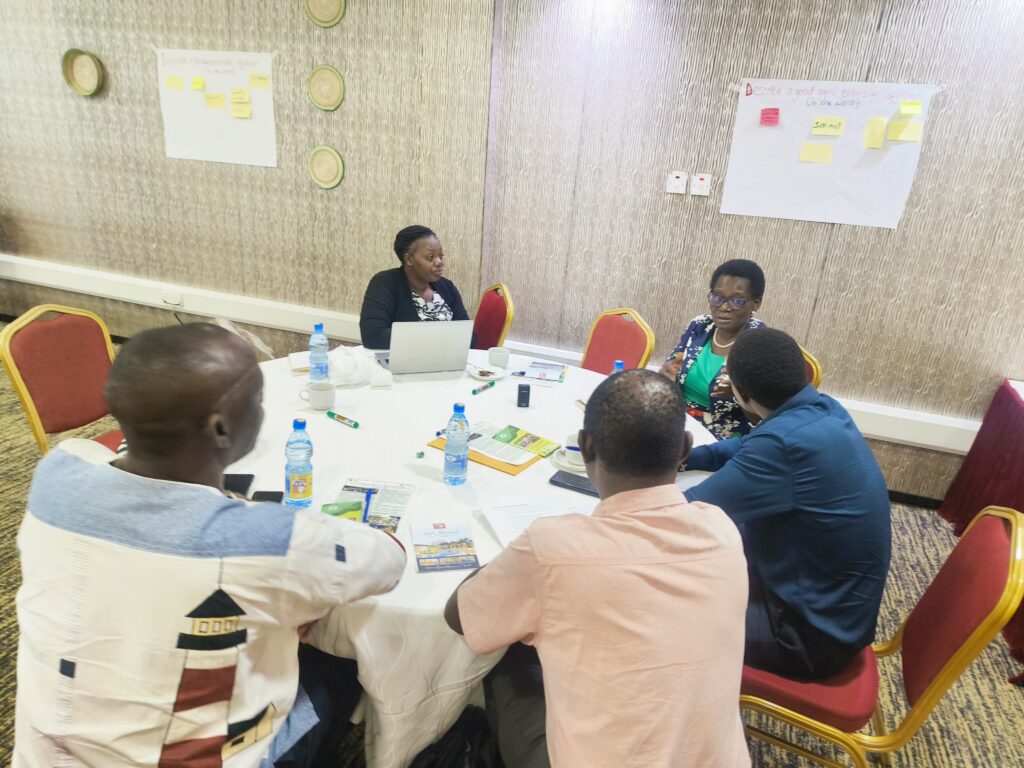
A section of participants during the IFPRI – UFAAS Gen AI workshop in Kampala. September, 2025
Lessons Learned
- Extension is irreducibly social, and people are central. AI cannot replace human empathy, trust-building, and observation.
- AI works best in a hybrid model. A combined approach, whereby traditional extension is enriched by digital intelligence, creates real value.
- Inclusivity must be deliberate. Gender norms, literacy gaps, and age-related barriers mean that the design of AI must intentionally support marginalized groups. The “how to” is the question.
- Skills upgrading is urgent. Extension workers need capacity building to harness AI rather than fear it.
- Agricultural advisory work is more than delivering information. It is about building trust, listening deeply, and responding to the realities of farmers’ lives.
Conclusion:
Artificial Intelligence is not a passing wave; it is here to stay (at least for now). For Uganda, where the extension–farmer ratio remains wide, AI offers a powerful tool to complement human expertise and has the potential to transform extension systems. The future lies in human-AI collaboration, where extension workers leverage AI to extend their reach, tailor services, and respond more quickly to farmers’ needs. This will ensure that farmers receive timely, relevant, and trusted advisory services in an era of digital transformation.
Generative AI can be a powerful tool in Uganda’s extension toolbox, a way to scale knowledge, tailor advice, and free extension workers to focus on complex, relational tasks. However, from the discussions at the IFPRI workshop, it is clear that transformation won’t come from technology alone. It will require intentional design for local realities, strong human oversight, gender-responsive delivery channels, and policies that protect farmers’ data. The consensus was clear: while AI offers promise, the heartbeat of extension is human.
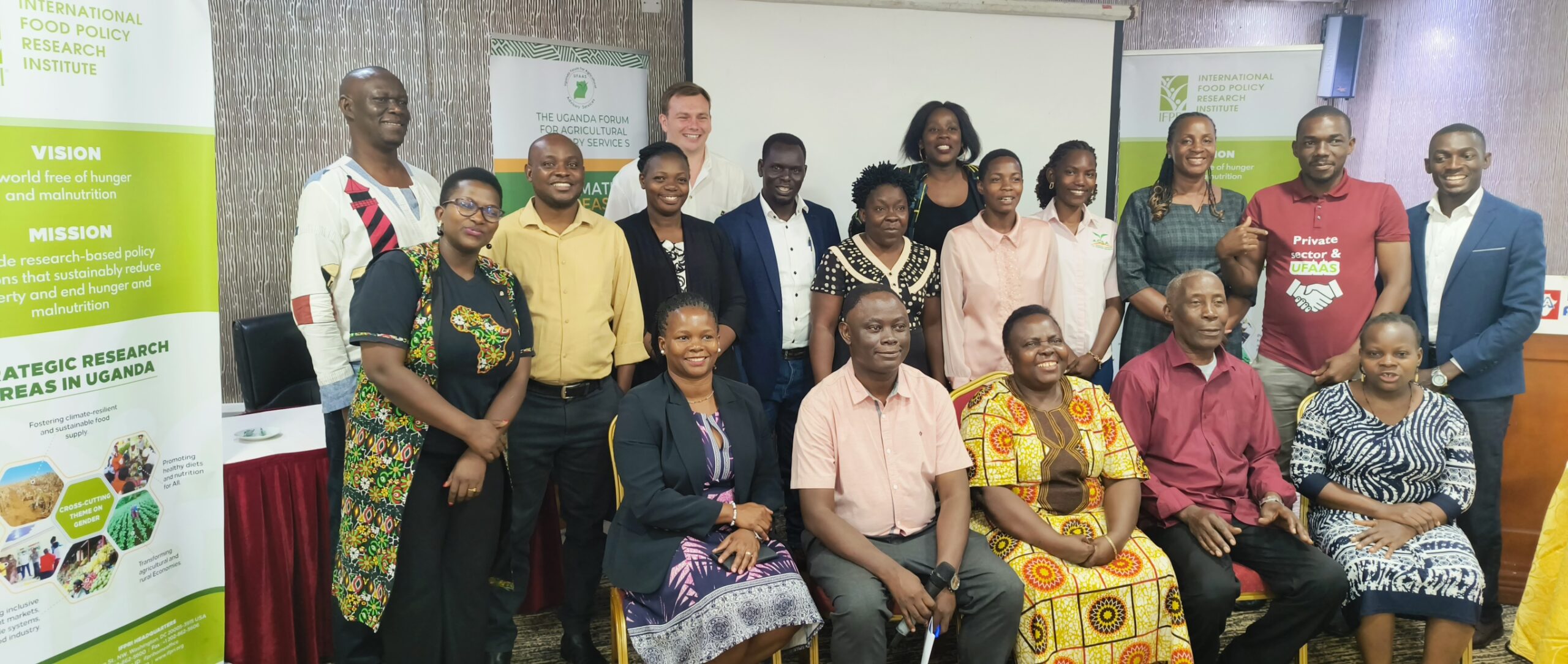
Group photo of some agricultural extension actors at the IFPRI – UFAAS Gen AI workshop in Kampala. September, 2025
Elizabeth Asiimwe is a volunteer staff in the Communications and Knowledge Management Unit at the Uganda Forum for Agricultural Advisory Services (UFAAS)/ PhD Student of Agricultural and Rural Innovation at Makerere University; Kristin Davis is a Senior Research Fellow in the Natural Resources and Resilience (NRR) Unit at the International Food Policy Research Institute (IFPRI).
Disclaimer: The views and opinions expressed in this blog are those of the authors and do not necessarily reflect the official position of their affiliated organizations.

